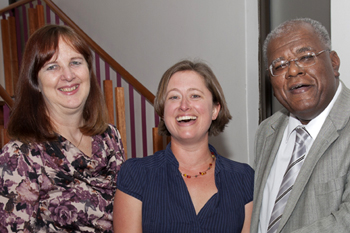Prestigious awards, membership and two A-ratings from the NRF indicate a boom in research

Several UFS researchers were honoured with awards this year. This includes, from the left: Prof Jeanet Conradie from the Department of Chemistry, Dr Aliza le Roux from the Department of Zoology and Entomology on the Qwaqwa Campus of the UFS, Profs Jonathan Jansen, Vice-Chancellor and Rector of the UFS.
Photo: Hannes Pieterse |
The University of the Free State (UFS) had several highlights in the field of research this year. This includes two A-ratings, which were awarded by the National Research Foundation (NRF) to Prof Maxim Finkelstein from the Department of Mathematics and Actuarial Science, and Prof Melanie Walker, Senior Research Professor and Director of the Centre for Research on Higher Education and Development (CRHED) and DST/NRF Chair in Higher Education and Human Development.
Prof Finkelstein’s A2-rating makes him the only A-rated researcher in ‘Probability and Statistics’ regarding Mathematical Sciences in the country. Prof Walker was evaluated in the division for Research, Innovation Support and Advancement and received an A1-rating.
Prof Jonathan Jansen, Vice-Chancellor and Rector of the UFS, considers these ratings as one of the clearest signs that the standard for research across the institution has increased significantly.
Prof Jansen was honoured with the Academy of Science of South Africa’s (ASSAf’s) Science-for-Society Gold Medal for his outstanding achievement in scientific thinking to the benefit of society.
"An award such as this recognises the power of science and scholarship to improve the human condition," Prof Jansen said.
A further highlight at ASSAf’s prestigious annual awards ceremony was the induction of Prof Jeanet Conradie from the Department of Chemistry and Dr Aliza le Roux from the Department of Zoology and Entomology on the UFS’s Qwaqwa Campus as new members of ASSAf.
Prof Conradie was also this year’s first runner-up in the senior category for Distinguished Women Researchers: Physical and Engineering Science in the Department of Science and Technology’s 2014 Women in Science Awards.
Prof Corli Witthuhn: Vice-Rector: Research, describes Prof Conradie as a highly productive researcher who publishes in high-impact journals.
“Not only is she the first female professor in the Department of Chemistry, but she also has extensive international networks and collaboration which elevates the impact of her work even further,” Prof Witthuhn said.
Dr Le Roux is one of ten young researchers inaugurated as members of the South African Young Academy of Science (SAYAS). She was also elected to serve on the executive committee of SAYAS. According to Prof Witthuhn, Dr Le Roux is an outstanding young scientist.
“I am very excited about the young researchers on our Qwaqwa Campus, with Aliza as one of the leaders, and I am looking forward to what they will achieve in the next five years,” she said.